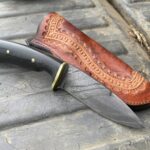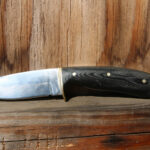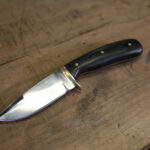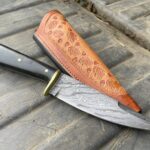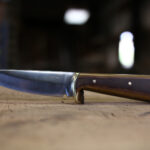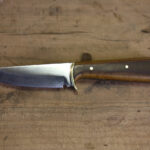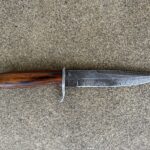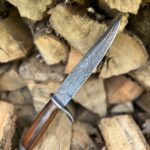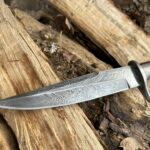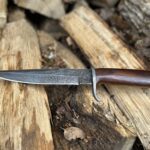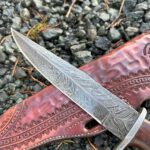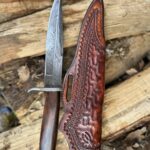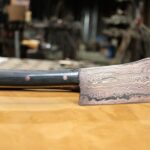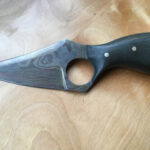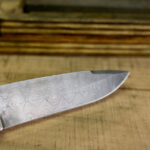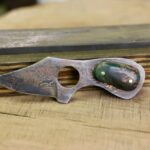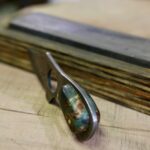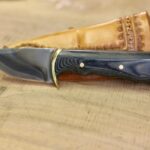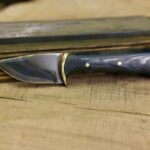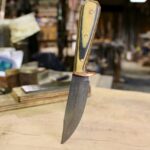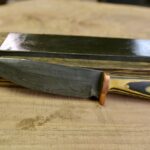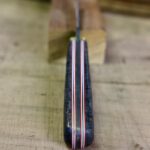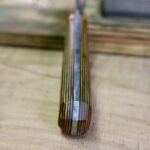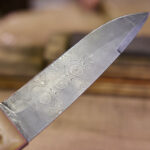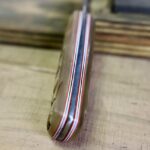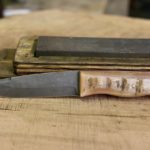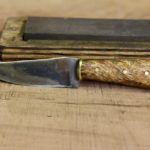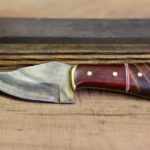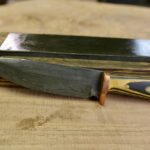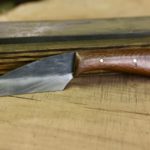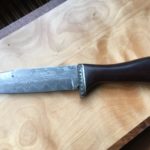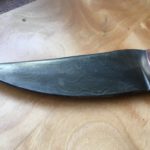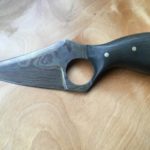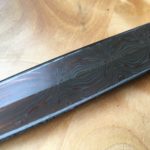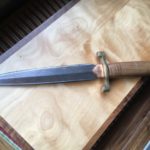Hunter
The Hunter is a versatile and classic knife profile designed for skinning, field dressing, boning, cooking, and more.
The drop point allows maximum control while skinning and dressing while maintaining tip strength.
The gentle curve of the handle and blade create a knife that is extremely comfortable in the hand and natural to use.
The top of the blade has a false edge for easier insertion.
I highly recommend adding a sheath to this knife as it will greatly increase your ability to safely carry and transport the knife.
Steve Harris will build the sheath custom to your knife. I give Steve fill creative control when designing and carving the leather and I am always blown away.
Camper
The Camper is my most popular knife and is usually the best choice for people who intend to use the knife in regular day to day life.
The knife profile is fantastic for cooking whether in the kitchen or at a campsite. I usually make the knife heavy and strong and it can perform very well in all other extreme uses, almost like a mini Bowie knife.
If you know you will use the knife exclusively in the kitchen I will make it slightly smaller and thinner since the added strength / weight is unnecessary for exclusively use while cooking. For kitchen use I also remove the hand guard. This allows the blade to fully hit the cutting board if you are chopping or slicing.
If the knife will be carried in your truck please order a sheath to keep yourself safe. You are much more likely to use the knife if you are able to safely pack it away.
The Camper has a brass finger guard however if the knife will only be used in the kitchen this can be left off since it is expected that you won't be pushing or swinging much.
It the field it's nice to have a finger guard so you can confidently push on the knife handle even if your hands are wet or slippery.
Custom
Over my lifetime of making knives - nearly all of them have been 'custom'. It was only in 2018 with help from Scott and Nate that we refined and developed the Hunter and Camper above. Both of these knife designs are very popular and account for 80% of the knives I make and sell.
Occasionally I speak to someone who is looking for something a bit different.
These photos to the left show a small sample of the different types of knives I have made over the past few years.
Finger
This is a small fixed blade with a large hole for gripping with your index finger. The knife is very light weight and discreet. The blade has a slight belly and it works surprisingly well for skinning due to extreme control and short blade.
This is a fun knife to carry, it is instant conversation starter, and it punches above it's weight when a knife is needed.
Cattle Skinner
Skinning knives need a large handle so your full hand can grip and control the blade. I prefer a skinning knife with 3.5" - 4"5 blade.
This allows the full cutting edge to be accounted for and visible throughout the job which reduces the likelihood of a gouge or mistake.
For extra precision skinning a have made 'Stubbie Skinners with a blade around 3". These work well but personally I prefer at least 3.5" for the most productive skinning.
A skinning knife needs a large belly, and very slender point, however it needs to quickly reach full thickness to have strength for prying and boning uses.
For skinning I recommended 52-100 steel with a micarta handle.
Alaska Bowie
A Bowie knife is an American icon and is one of my favorite knifes to make. I tend to make the more slender than the traditional profile, likely because it reduces the weight greatly with minimal loss of utility.
I also like a long and slender clip point to increase ease of insertion and bone separation. After the clip a Bowie should be thick perhaps between 3/16 and 1/4 inch - to ensure the knife has enough strength for literally anything. Chopping, digging, chiseling, hogging out, splitting - anything is fair game for Bowie knife.
The Alaska Bowie (see photo on the left) is a good example of my preference for a bowie knife. This particular knife has a feather damascus pattern that is time consuming and complex to create. A polished steel Bowie may cost $750-$1,250 and a damascus or feather damascus version could cost up to $2,500 depending on how much time the particular knife takes.
I am working on a template and system for the Alaska Bowie that might bring the cost down. I think it is a blade that every man should own.
The sheath for the Alaska Bowie is a work of art in it's own right and should be mandatory if you buy one. The sheath is made custom to fit the knife and is a worthy companion. A proper sheath for a large Bowie knife could be up to $400.
Cleaver
A meat cleaver is large and heavy for chopping. I have used a cleaver for decades when processing beef. A lot of knives will chop through bone but a cleaver gets it done with much greater ease and speed. If you are processing or packaging meat this is a must have knife.
A cleaver is dangerous in a much different way. The other knives on this page will cut you - a cleaver will remove your finger completely.
I recommend going slow with this knife until you know what you are doing.
Fighter
A fighting knife is straight and sharp along both edges. It is long, slender, and lightweight.
For most of us these knives are decorative and a conversation piece. The symmetry and balance can result in a knife that is very enjoyable to handle. I have one at my desk that gets handled daily.
They are useful knives as well - especially in the kitchen if you need to fight some melons or other fruit.

